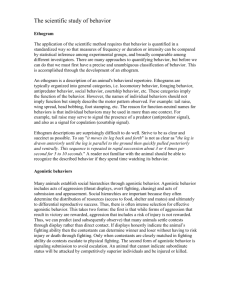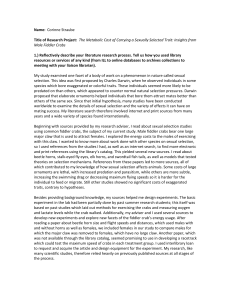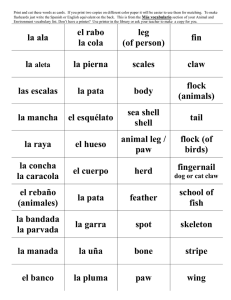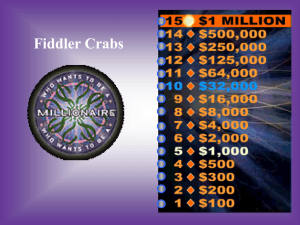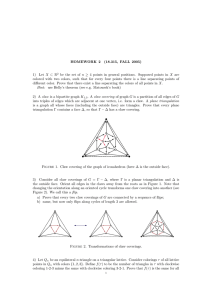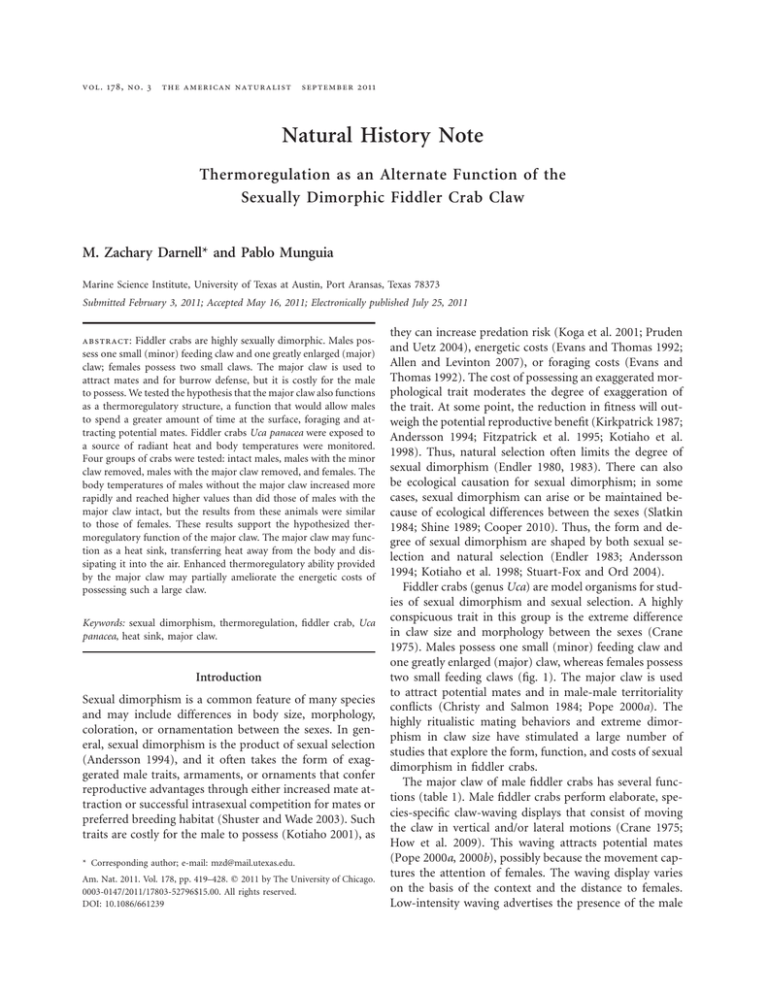
vol. 178, no. 3
the american naturalist
september 2011
Natural History Note
Thermoregulation as an Alternate Function of the
Sexually Dimorphic Fiddler Crab Claw
M. Zachary Darnell* and Pablo Munguia
Marine Science Institute, University of Texas at Austin, Port Aransas, Texas 78373
Submitted February 3, 2011; Accepted May 16, 2011; Electronically published July 25, 2011
abstract: Fiddler crabs are highly sexually dimorphic. Males possess one small (minor) feeding claw and one greatly enlarged (major)
claw; females possess two small claws. The major claw is used to
attract mates and for burrow defense, but it is costly for the male
to possess. We tested the hypothesis that the major claw also functions
as a thermoregulatory structure, a function that would allow males
to spend a greater amount of time at the surface, foraging and attracting potential mates. Fiddler crabs Uca panacea were exposed to
a source of radiant heat and body temperatures were monitored.
Four groups of crabs were tested: intact males, males with the minor
claw removed, males with the major claw removed, and females. The
body temperatures of males without the major claw increased more
rapidly and reached higher values than did those of males with the
major claw intact, but the results from these animals were similar
to those of females. These results support the hypothesized thermoregulatory function of the major claw. The major claw may function as a heat sink, transferring heat away from the body and dissipating it into the air. Enhanced thermoregulatory ability provided
by the major claw may partially ameliorate the energetic costs of
possessing such a large claw.
Keywords: sexual dimorphism, thermoregulation, fiddler crab, Uca
panacea, heat sink, major claw.
Introduction
Sexual dimorphism is a common feature of many species
and may include differences in body size, morphology,
coloration, or ornamentation between the sexes. In general, sexual dimorphism is the product of sexual selection
(Andersson 1994), and it often takes the form of exaggerated male traits, armaments, or ornaments that confer
reproductive advantages through either increased mate attraction or successful intrasexual competition for mates or
preferred breeding habitat (Shuster and Wade 2003). Such
traits are costly for the male to possess (Kotiaho 2001), as
* Corresponding author; e-mail: mzd@mail.utexas.edu.
Am. Nat. 2011. Vol. 178, pp. 419–428. q 2011 by The University of Chicago.
0003-0147/2011/17803-52796$15.00. All rights reserved.
DOI: 10.1086/661239
they can increase predation risk (Koga et al. 2001; Pruden
and Uetz 2004), energetic costs (Evans and Thomas 1992;
Allen and Levinton 2007), or foraging costs (Evans and
Thomas 1992). The cost of possessing an exaggerated morphological trait moderates the degree of exaggeration of
the trait. At some point, the reduction in fitness will outweigh the potential reproductive benefit (Kirkpatrick 1987;
Andersson 1994; Fitzpatrick et al. 1995; Kotiaho et al.
1998). Thus, natural selection often limits the degree of
sexual dimorphism (Endler 1980, 1983). There can also
be ecological causation for sexual dimorphism; in some
cases, sexual dimorphism can arise or be maintained because of ecological differences between the sexes (Slatkin
1984; Shine 1989; Cooper 2010). Thus, the form and degree of sexual dimorphism are shaped by both sexual selection and natural selection (Endler 1983; Andersson
1994; Kotiaho et al. 1998; Stuart-Fox and Ord 2004).
Fiddler crabs (genus Uca) are model organisms for studies of sexual dimorphism and sexual selection. A highly
conspicuous trait in this group is the extreme difference
in claw size and morphology between the sexes (Crane
1975). Males possess one small (minor) feeding claw and
one greatly enlarged (major) claw, whereas females possess
two small feeding claws (fig. 1). The major claw is used
to attract potential mates and in male-male territoriality
conflicts (Christy and Salmon 1984; Pope 2000a). The
highly ritualistic mating behaviors and extreme dimorphism in claw size have stimulated a large number of
studies that explore the form, function, and costs of sexual
dimorphism in fiddler crabs.
The major claw of male fiddler crabs has several functions (table 1). Male fiddler crabs perform elaborate, species-specific claw-waving displays that consist of moving
the claw in vertical and/or lateral motions (Crane 1975;
How et al. 2009). This waving attracts potential mates
(Pope 2000a, 2000b), possibly because the movement captures the attention of females. The waving display varies
on the basis of the context and the distance to females.
Low-intensity waving advertises the presence of the male
420
The American Naturalist
Figure 1: Female (A) and male (B) Uca panacea. Scale bars indicate
1 cm.
and the breeding burrow over long distances, while highintensity waving occurs when females are in close proximity and is directed toward a specific female (Pope 2005).
Males with a larger major claw relative to their body size
are more successful in attracting potential mates than are
males with a relatively smaller major claw, suggesting that
claw size also plays a role in female choice (Oliveira and
Custodio 1998; Pratt and McLain 2002; McLain and Pratt
2007). Even the height of the wave can be an important
target of female choice (Murai et al. 2009). Claw size is
also important in intrasexual combat, as males with larger
major claws are more successful in territory disputes (Hyatt and Salmon 1978). In many species, the major claw is
brightly colored, with colors varying between species. The
color of the claw, including reflectance at ultraviolet wavelengths, is used as a species-recognition signal during female mate choice (Detto et al. 2006; Detto 2007; Detto
and Backwell 2009).
The costs to a male fiddler crab of possessing such a
greatly enlarged claw are substantial. Waving of the major
claw is energetically costly, as is evidenced by increased
blood-lactate levels in waving male fiddler crabs (Matsumasa and Murai 2005). The presence of the major claw
also results in increased mass-specific metabolic rates and
decreased endurance capacity (Allen and Levinton 2007).
The foraging ability of male fiddler crabs is altered by the
large claw. While foraging, male crabs are limited by their
single minor claw; the major claw is not functional for
feeding, and males thus have a lower food intake rate than
females (Valiela et al. 1974; Weissburg 1992, 1993). Additionally, while at the surface performing the waving display, males are both heat and food stressed (Allen 2007).
The conspicuousness of the major claw may further increase predation risk (Koga et al. 2001). Finally, as claw
mass increases, the height of the wave decreases, resulting
in decreased success in attracting females (Murai et al.
2009). Clearly, the presence of the large male claw has
been well explored, showing the mating advantages and
potential costs associated with such an ornament.
The major claw of male fiddler crabs is greatly enlarged,
despite the costs. Major claw size varies among species,
but it can account for nearly one-half of total body mass
in some species (Crane 1975; Christy and Salmon 1984).
Because of the large size of the major claw, other legs on
the same side of the body are often enlarged, presumably
for additional support during lateral waving (Huxley and
Callow 1933; Takeda and Murai 1993). We hypothesize
that the major claw confers additional benefits beyond
those related to sexual selection that may partially ameliorate the costs of the major claw and contribute to the
high degree of exaggeration in claw size.
We hypothesize that one such additional benefit of the
major claw is increased thermoregulatory ability. If the
major claw of male fiddler crabs confers a thermal or
thermoregulatory benefit, it may partially ameliorate the
energetic costs of possessing it. The major claw may confer
a thermal benefit through passive processes, such as evaporative cooling and convective heat transfer, or through
active physiological (regulatory) mechanisms. Behavioral
mechanisms such as claw waving and changing claw orientation may increase the thermoregulatory benefit of the
major claw beyond the passive benefit provided by the
structure of the claw itself. Male Uca rapax and Uca pugilator often emerge from burrows in the morning, facing
the sun and extending the major claw (Smith and Miller
1973), possibly as a means of regulating body temperature
by rapid heat gain. Additionally, Windsor et al. (2005)
demonstrated that heat is rapidly transferred between the
body and the major claw of male U. pugilator. These observations support the hypothesized thermoregulatory
function of the claw. We tested our hypothesis in the fiddler crab Uca panacea Novak and Salmon, a sister species
Thermoregulation in Fiddler Crabs 421
Table 1: Traits and functions associated with the major claw in fiddler crabs, and example studies that explore
such traits
Trait, function
Reference
Claw waving:
To increase conspicuousness to
females
As a courtship signal to females
Low-intensity waving:
To advertise presence over long
distances
High-intensity waving:
To attract nearby wandering
females
Height of wave:
To increase attractiveness to
females
Structure of wave:
As conspecific identification
Claw color:
As conspecific identification
Claw size:
To increase attractiveness to females
In male-male territory disputes
In thermoregulation
Cummings et al. 2008
Pope 2000a, 2000b
Pope 2005
Pope 2005
Murai and Backwell 2006; Murai et al. 2009
Salmon et al. 1978; Zucker and Denny 1979
Detto et al. 2006; Detto 2007; Detto and Backwell 2009
Oliveira and Custodio 1998; Pratt and McLain 2002; McLain
and Pratt 2007
Hyatt and Salmon 1978
This study
to U. pugilator (Novak and Salmon 1974; Rosenberg 2001)
that inhabits sandy substrates along the coast of the Gulf
of Mexico.
Methods
Adult Uca panacea (fig. 1) were collected from a salt marsh
at the Mustang Beach Airport, Port Aransas, Texas
(27748.680N, 97705.360W), in July and August, 2010. Crabs
were transported to the University of Texas Marine Science
Institute where they were placed into holding tanks, which
contained running seawater and sand from the collection
site, that had been inclined such that approximately onehalf of the bottom of the tank was under water. Crabs
were fed daily (Wardley Tropical Fish Flake Food and HBH
Crab and Lobster Bites) and used in experiments within
1 week of collection.
Relationships between claw size and body size were assessed for male U. panacea. Each crab was weighed and
induced to autotomize either the major or the minor claw
by squeezing the merus of the claw with forceps. This
procedure resulted in immediate autotomy of the claw.
Autotomy is a common predator defense mechanism
among decapod crustaceans (Paul 1915; Robinson et al.
1970; Smith and Hines 1991; Wasson et al. 2002). Crabs
are able to autotomize, or self-amputate, an appendage
along a defined breaking plane (Paul 1915). Following
autotomy, a diaphragm membrane rapidly seals off the
wound to prevent blood loss (Paul 1915), and regeneration
of autotomized limbs occurs within several molts. Induced
autotomy is a commonly used practice in studies on crustaceans and is generally assumed to result in minimal stress
to the organism (Allen and Levinton 2007; Barria and
Gonzalez 2008; Patterson et al. 2009). The autotomized
claw was weighed immediately after separation. Body mass
was determined by subtracting claw mass from total crab
mass. Claws were measured on a total of 96 crabs: 48 for
determining major claw size and 48 for determining minor
claw size. To determine scaling of the major claw with
body size, claw mass was regressed against body mass.
To test for differences in thermoregulatory ability between the sexes, both male and female crabs were exposed
to a source of radiant heat and body temperatures were
monitored. To test the effects of the major claw on thermoregulatory ability, crabs (not the same crabs used for
claw measurements) were assigned to one of the following
four treatments: (1) intact females, (2) intact males, (3)
males with the major claw removed, and (4) males with
the minor claw removed. Autotomy was induced, using
the method described above. Following claw removal,
crabs were held for 1 h at room temperature in inclined
tanks (as above) before being used in experiments. None
of the crabs died in the hour between claw removal and
the start of the experiment.
422
The American Naturalist
To normalize water content among crabs, each crab was
submerged in a cup of room-temperature seawater for 1
min before being placed into a dry cup at room temperature (∼257C) for 15 min. Each crab was then weighed
and photographed against a white background. Carapace
temperature, used as a proxy for internal body temperature, was measured with an infrared thermometer (model
42512, Extech Instruments, Waltham, MA).
Lamps containing 60-W soft-white incandescent bulbs
provided a source of radiant heat and were positioned with
the reflectors pointed directly downward, 21 cm above the
surface of a table. Four clear plastic cups were placed under
each lamp, with one crab in each cup. Cups were arranged
such that each cup received a similar amount of light and
heat. Irradiance at the position of the cups, which was
measured with a CMP-3 pyranometer (Kipp & Zonen,
Delft), was ∼400 W m22. Each set of four cups was considered as one block for statistical analyses and contained
one crab from each of the four treatments. Every 10 min,
each crab was weighed and body temperature was measured with the infrared thermometer. The positions of the
four crabs under a lamp were rotated following each measurement. Each individual was exposed for 90 min. This
time period was chosen on the basis of preliminary experiments and resulted in substantial increases in body
temperature with minimal mortality. Behavior of crabs
held in the cups was not quantified systematically. We did
not, however, observe any obvious differences in behavior,
posture, or claw orientation between the four treatments.
At the conclusion of the experiment, the crabs were again
photographed against a white background.
Fiddler crabs are able to change the shade of the carapace in response to temperature changes (Silbiger and
Munguia 2008), and carapace shade likely has effects on
the absorption of radiant energy and thus on body temperature. To test for differences in carapace shade and
carapace color-change responses among the four treatments, carapace shade was determined for all crabs, using
the methods described by Silbiger and Munguia (2008).
Photographs were converted to grayscale and analyzed using ImageJ software (National Institutes of Health, Bethesda, MD). Using only the area of the carapace, a histogram was created for each image, showing the
distribution of pixel intensities, ranging from 0 (black) to
255 (white). A gamma distribution was fitted to each histogram, generating a shape parameter g that described the
shade of the carapace, with higher g values corresponding
to a lighter shade and lower g values corresponding to a
darker shade. Carapace shade was analyzed using a twoway repeated-measures ANOVA testing for significant effects of treatment, time (before or after the 90-min experimental period), and a treatment # time interaction.
Decreases in crab mass were nonlinear. To standardize
for the initial mass of each crab, masses were converted
to percentages of the initial mass for desiccation rate analyses. An exponential decay function was fitted for each
crab, with the form
M b p a(e2bt) 1 c,
where Mb is the percentage of initial body mass at time t
and b is the desiccation-rate constant. The parameter a
was held constant for all crabs. An exponential decay function was chosen because it produced the best fit to the
data. Mean 5 SE R2 value was 0.99 5 0.001. The percent
change in total body mass over the full 90-min experiment
was also calculated for each crab.
Body temperature increases were also nonlinear, and
heating rate was determined for each crab using logarithmic regression. Logarithmic regression was chosen because
it produced the best fit to the data. A regression line was
fitted for each crab, with the form
Tb p m ln (t 1 0.1) 1 b,
where Tb is body temperature at time t and m is the heating-rate constant. In order to incorporate time zero into
the regression, 0.1 min was added to each time measurement. R2 values averaged 0.91 5 0.01. Additionally, the
total change in Tb was calculated for each crab by subtracting the initial body temperature from the final body
temperature.
Desiccation-rate constants, total changes in Mb, heatingrate constants, and total change in Tb were analyzed using
mixed-effects ANCOVA, where treatment was the fixed
effect, initial crab mass (after claw autotomy) was the covariate, and blocks were random effects. Each model also
tested for a treatment # mass interaction. In all cases, if
ANCOVA indicated a significant effect of treatment, then
a Tukey HSD test was used for all pairwise comparisons
among treatments. Analyses were conducted in JMP, version 8.0.2 (SAS Institute, Cary, NC), and SigmaPlot 11.0
(Systat Software, Chicago, IL).
Results
Mass (mean 5 SE) of the major claw of male Uca panacea
was 27.3% 5 0.42% of crab mass (2.09 5 0.07 g). One
crab had a much smaller major claw (11.9% of crab mass),
likely due to regeneration following autotomy that occurred in the field before collection, and so was excluded
from further analyses. Major claw mass increased isometrically with body mass (major claw mass p 0.417 #
body mass 2 0.050; R 2 p 0.86; fig. 2). Mass of the minor
claw averaged 1.7% 5 0.01% of total body mass.
A total of 21 heating trials were conducted, resulting in
21 replicates for each of the four treatments and a total
of 84 crabs (mass, 1.85 5 0.04 g). Of the 84 crabs used,
Thermoregulation in Fiddler Crabs 423
the minor claw removed (fig. 5B). Heating rate also varied
with crab mass; body temperatures of larger crabs increased faster than did those of smaller crabs (table 2; fig.
5C). Additionally, there was a significant treatment #
mass interaction (table 2; fig. 5C).
Total change in Tb also varied among treatments (table
2). Body temperature increases in females (11.087 5
0.357C) and in males with the major claw removed
(9.547 5 0.357C) were significantly greater than those in
intact males (8.817 5 0.347C) and in males with the minor
claw removed (8.087 5 0.347C). Total change in body temperature also varied with crab size; body temperatures of
larger crabs increased more than did those of smaller crabs
(table 2). There was no interaction between treatment and
mass.
Figure 2: Major claw mass regressed against body mass (total mass
minus major claw mass).
Discussion
two died during the experiment, between 80 and 90 min
after placement under the lamp, probably due to overheating (see below). One of these crabs was a female and
the other was a male with the major claw removed. These
two crabs were included in analyses of heating and desiccation rates but were excluded from analyses of total
change in body temperature and mass.
Carapace shade, measured as a g value, differed among
the four treatments (table 2); males with the major claw
removed had significantly higher g values (indicating
lighter shade) than did females or intact males, while males
with the minor claw removed had intermediate g values.
Crabs in all four treatments became significantly lighter
over the course of the experiment (table 2; fig. 3), with a
mean change in g of 0.057 5 0.011 (21.36% 5 4.51%).
There was no significant treatment # time interaction.
Crabs lost, on average, 7.64% 5 0.12% of initial body
mass over the 90-min experimental period (fig. 4A). Desiccation-rate constants (b) averaged 0.012 5 0.0003, and
neither desiccation rate nor total change in Mb differed
among treatments (table 2; fig. 4B). Both desiccation rate
and total change in Mb varied with crab mass; body masses
of larger crabs decreased more slowly than did those of
smaller crabs, and larger crabs lost a smaller percentage
of body mass than did smaller crabs (table 2; fig. 4C).
There were no significant treatment # mass interactions.
Body temperatures increased an average of 9.367 5
0.217C over the 90-min experimental period for all treatments combined. Body-temperature increases were not
linear over time but were characterized by a rapid increase
over the first 10 min, after which the rate of increase slowed
(fig. 5A). Heating-rate constants (m) averaged 1.40 5
0.03 but differed among treatments (table 2). Females and
males with the major claw removed had significantly
higher heating rates than did intact males or males with
The purpose of this study was to test the hypothesis that
the enlarged male claw plays a role in thermoregulation
of the fiddler crab Uca panacea. Removal of the major
claw significantly affected the rate of increase in body temperature when a crab was exposed to a source of radiant
heat; males lacking the major claw exhibited more rapid
increases in body temperature and a greater total increase
in body temperature than did intact males or males with
the minor claw removed. These results complement previous findings on the importance of morphological traits
Table 2: Results of statistical analyses
Source
df
F
P
3
1
3
6.349
28.565
1.332
!.001
!.001
a
Carapace shade g:
Treatment
Time
Treatment # time
Desiccation rate b:
Treatment
Mass
Treatment # mass
Total change in Mb:b
Treatment
Mass
Treatment # mass
Heating rate m:
Treatment
Mass
Treatment # mass
Total change in Tb:
Treatment
Mass
Treatment # mass
a
b
3
1
3
2.5323
9.4817
.3882
.270
.065
.003
.762
3
1
3
2.445
13.389
.579
.074
3
1
3
59.028
71.938
3.393
!.001
!.001
3
1
3
29.003
39.377
1.802
!.001
!.001
!.001
.631
.023
.156
From the gamma distribution that described shade.
Relative body mass.
424
The American Naturalist
in butterflies (Clench 1966). Similarly, fiddler crabs take
refuge in their burrows, change their orientation relative
to the sun, or move between surface microhabitats to
maintain body temperature (Smith and Miller 1973; Pow-
Figure 3: Mean g values before and after the experiment for each
of the four treatments (g is the shape parameter from the gamma
distribution describing shade). A higher value of g represents a lighter
shade. Crabs in all four treatments became lighter in color following
exposure to heat. Error bars indicate 5SE.
in ectotherm thermoregulation (e.g., Wasserthal 1975;
Shepherd et al. 2008) and provide evidence supporting an
alternative function of the major claw, a function that has
potentially positive benefits for male crabs and that can
ameliorate the energetic and foraging costs of enlarged
claws.
Heating rates were similar between intact males and
males with the minor claw removed. Heating rates for
males with the major claw removed, however, were higher
and similar to the rates observed for females (fig. 5B).
Examining the total increase in body temperature confirmed these results. These data suggest that the major
claw is involved in thermoregulation in Uca panacea. The
major claw may function as a heat sink, moving heat away
from the body and dissipating it into the surrounding air.
Windsor et al. (2005) found that heat is rapidly transferred
between the major claw and the body of the fiddler crab
Uca pugilator, though further study is necessary to resolve
the mode of heat transfer (passive conduction or an active
physiological process) between the body and claw. The
relative size of the major claw may also influence thermoregulatory ability, as a larger claw (relative to body size)
should perform better as a heat sink.
Thermoregulatory mechanisms in ectotherms are generally behavioral, such as basking by reptiles (Bauwens et
al. 1996) and altering wing orientation relative to the sun
Figure 4: Results of body mass measurements: A, average relative
body mass over the 90-min experimental period and B, least squares
mean desiccation constants (b) for each treatment. Error bars indicate
5SE. There were no significant differences among treatments. In C,
desiccation-rate constants are regressed against crab mass; the line
represents the overall regression.
Thermoregulation in Fiddler Crabs 425
Figure 5: Results of body temperature measurements: A, average
body temperatures over the 90-min experimental period and B, least
squares mean heating-rate constants (m) for each treatment. Error
bars indicate 5 SE. Different letters above bars indicate significantly
different values at P ! .05 with a Tukey HSD test. In C, heating-rate
constants are regressed against crab mass for each of the four treatments. The solid line represents females, the long-dashed line represents males with the major claw removed, the short-dashed line
represents intact males, and the dotted line represents males with
the minor claw removed.
ers and Cole 1976; Thurman 1998). When presented with
a temperature gradient, preferred temperatures are at or
slightly below the body temperature at which locomotor
performance is maximized (Allen 2007; B. J. Allen and J.
S. Levinton, personal communication). Fiddler crabs also
change the shade and pattern of the carapace by dispersing
or contracting chromatophores in response to temperature
changes (Brown and Sandeen 1948; Silbiger and Munguia
2008). By blanching at high temperatures, fiddler crabs
are able to increase the reflectance of the carapace and
thus remain cooler (Wilkens and Fingerman 1965). We
observed crabs in all four treatments becoming lighter after
exposure to heat. Males with the major claw removed had
the lightest coloration (fig. 3), perhaps indicating blanching of the carapace in response to induced claw autotomy.
This difference in shade, however, does not explain the
observed differences in heating rate, as males with the
major claw removed had the greatest heating rate, and not
a lower heating rate as predicted for a light-colored crab.
There was no treatment # time interaction, indicating
that the change in carapace shade during the experiment
did not differ among the four treatments.
Claw waving has the potential to increase the thermoregulatory function of the major claw, as increased airflow
over the claw during waving would increase the rate of
heat dissipation. Waving was not observed in this study,
likely because of the continuous presence of the experimenter. Additionally, altering the orientation of the large
claw relative to the sun could be an important behavioral
mechanism for heat gain following emergence from burrows. Although orientation was not systematically examined in this experiment, no obvious differences in posture
or claw orientation were observed among the four treatments. Thus, in nature, the thermoregulatory benefit of
the major claw may be greater than that observed here,
because of behavioral mechanisms. Heat gain is also likely
to vary on the basis of the water content of the crab. Here
we attempted to standardize water content among the four
treatments by immersing each crab in seawater for 1 min,
followed by a 15-min period in a dry cup. In the field,
however, fiddler crabs may have substantially lower water
contents, leading to differences in heating rates and heat
gain.
In contrast to the general observation that larger organisms are better able to maintain stable body temperature than are smaller organisms, we observed that both
heating rate and total change in body temperature increased with increasing body size. We hypothesize that
these relationships are the result of differences in the rate
of heat loss between large and small crabs, driven by differences in evaporative cooling rates based on body size.
Our observation that the U. panacea desiccation rate was
inversely related to crab mass (fig. 4) is consistent with
the general observation that smaller organisms generally
lose water faster than do larger organisms because of increased surface area relative to body volume. Thus, body
temperatures likely remained lower in smaller crabs than
426
The American Naturalist
in larger crabs because of heat loss from evaporative cooling. Fiddler crabs are generally able to lower their body
temperature several degrees below the ambient environmental temperature through this mechanism (Edney 1961;
Wilkens and Fingerman 1965; Thurman 1998). There was
also a significant treatment # mass interaction in the
analysis of heating rate. The heating rates of males with
the major claw removed were more sensitive to body size
than were the heating rates of the other three treatments,
as indicated by the increased slope of the heating rate by
mass regression (fig. 5C). Neither desiccation rate nor percent change in body mass differed among the four treatments, indicating that differences in evaporative cooling
did not underlie the observed differences in heating rates
among the four treatments.
While these observations support the hypothesized thermoregulatory function of the enlarged male claw, further
experiments are necessary to conclusively demonstrate this
function. We have demonstrated here that the major claw
confers a thermal benefit to male fiddler crabs when they
are exposed to high temperatures; this study is the first
step toward a better understanding of the ecological role
of the sexually selected major claw. Future research should
resolve whether active or passive processes are responsible
for this thermal benefit, focus on the roles of mechanisms
such as evaporative cooling and convective heat transfer
in heat loss through the major claw, examine hemolymph
flow between the body and claw, and assess the effects of
behavioral mechanisms on the thermal benefit provided
by the major claw. Our observations, while they do not
provide conclusive evidence of a thermoregulatory function, should stimulate further research on the ecological
and physiological functions of the major claw, a structure
previously considered only in the context of sexual
selection.
By exploring ecological functions of sexually selected
traits, we can better quantify costs and benefits associated
with trait function. Furthermore, such an approach can
be enhanced by examining the relationship of form and
function in the context of both sexual and natural selection. Here we present evidence that the major claw of male
fiddler crabs functions not only to attract mates and in
male-male competition, as previously shown, but also as
a thermoregulatory organ. We hypothesize that the major
claw functions as a heat sink, moving heat away from the
body and dissipating heat it the environment. Similar morphological heat sinks are present in other organisms and
include the horns of horned beetles (Shepherd et al. 2008),
the large ears of jackrabbits (Hill and Veghte 1976; Hill et
al. 1980) and elephants (Phillips and Heath 1992; Weissenböck et al. 2010), the bills of toucans (Tattersall et al.
2009), and the horns of goats (Taylor 1966; Picard et al.
1999). In fiddler crabs, a thermoregulatory function of the
major claw would allow male crabs to remain at the surface
longer to compensate for their reduced feeding efficiency
and would also allow the crab to perform the waving display longer before having to retreat into the burrow. Thus,
while sexual dimorphism is the product of sexual selection,
these traits can still have physiological advantages beyond
mating. Fiddler crabs have long been used as a lens through
which to explore mating behavior and sexual selection
(table 1) and thus provide an ideal opportunity to investigate the ecological importance a sexually selected trait,
the male’s enlarged major claw.
Acknowledgments
We thank Stephanie Kronstadt for her assistance with data
collection. K. Bittler, A. Johnson, S. Linn, and J. Rowley
assisted with crab collection. We are also grateful to B.
Alenius, C. Cook, K. Darnell, M. Ogburn, A. Ojanguren,
P. Rodgers, M. Salmon, and four anonymous reviewers for
valuable feedback on this manuscript. Funding for this
study was partially provided by the NSF Research Experience for Undergraduates program.
Literature Cited
Allen, B. J. 2007. Costs of sexual selection in the sand fiddler crab,
Uca pugilator. PhD diss. Stony Brook University, Stony Brook, NY.
Allen, B. J., and J. S. Levinton. 2007. Costs of bearing a sexually
selected ornamental weapon in a fiddler crab. Functional Ecology
21:154–161.
Andersson, M. B. 1994. Sexual selection. Princeton University Press,
Princeton, NJ.
Barria, E. M., and M. I. Gonzalez. 2008. Effect of autotomy and
regeneration of the chelipeds on growth and development in Petrolisthes laevigatus (Guerin, 1835) (Decapoda, Anomura, Porcellanidae). Crustaceana 81:641–652.
Bauwens, D., P. E. Hertz, and A. M. Castilla. 1996. Thermoregulation
in a lacertid lizard: the relative contributions of distinct behavioral
mechanisms. Ecology 77:1818–1830.
Brown, F. A., Jr., and M. I. Sandeen. 1948. Responses of the chromatophores of the fiddler crab, Uca, to light and temperature.
Physiological Zoology 21:361–371.
Christy, J. H., and M. Salmon. 1984. Ecology and evolution of mating
systems of fiddler crabs (genus Uca). Biological Reviews of the
Cambridge Philosophical Society 59:483–509.
Clench, H. K. 1966. Behavioral thermoregulation in butterflies. Ecology 47:1021–1034.
Cooper, I. A. 2010. Ecology of sexual dimorphism and clinal variation
of coloration in a damselfly. American Naturalist 176:566–572.
Crane, J. 1975. Fiddler crabs of the world (Ocypodidae: genus Uca).
Princeton University Press, Princeton, NJ.
Cummings, M. E., J. M. Jordao, T. W. Cronin, and R. F. Oliveira.
2008. Visual ecology of the fiddler crab, Uca tangeri: effects of sex,
viewer and background on conspicuousness. Animal Behaviour
75:175–188.
Thermoregulation in Fiddler Crabs 427
Detto, T. 2007. The fiddler crab Uca mjoebergi uses colour vision in
mate choice. Proceedings of the Royal Society B: Biological Sciences 274:2785–2790.
Detto, T., and P. R. Y. Backwell. 2009. The fiddler crab Uca mjoebergi
uses ultraviolet cues in mate choice but not aggressive interactions.
Animal Behaviour 78:407–411.
Detto, T., P. R. Y. Backwell, J. M. Hemmi, and J. Zeil. 2006. Visually
mediated species and neighbour recognition in fiddler crabs (Uca
mjoebergi and Uca capricomis). Proceedings of the Royal Society
B: Biological Sciences 273:1661–1666.
Edney, E. J. 1961. The water and heat relations of fiddler crabs (Uca
spp.). Transactions of the Royal Society of South Africa 36:71–91.
Endler, J. A. 1980. Natural selection on color patterns in Poecilia
reticulata. Evolution 34:76–91.
———. 1983. Natural and sexual selection on color patterns in poeciliid fishes. Environmental Biology of Fishes 9:173–190.
Evans, M. R., and A. L. R. Thomas. 1992. The aerodynamic and
mechanical effects of elongated tails in the scarlet-tufted malachite
sunbird: measuring the cost of a handicap. Animal Behaviour 43:
337–347.
Fitzpatrick, S., A. Berglund, and G. Rosenqvist. 1995. Ornaments or
offspring: costs to reproductive success restrict sexual selection
processes. Biological Journal of the Linnean Society 55:251–260.
Hill, R. W., and J. H. Veghte. 1976. Jackrabbit ears: surface temperatures and vascular responses. Science 194:436–438.
Hill, R. W., D. P. Christian, and J. H. Veghte. 1980. Pinna temperature
in exercising jackrabbits, Lepus californicus. Journal of Mammalogy
61:30–38.
How, M. J., J. Zeil, and J. M. Hemmi. 2009. Variability of a dynamic
visual signal: the fiddler crab claw-waving display. Journal of Comparative Physiology A 195:55–67.
Huxley, J. S., and F. S. Callow. 1933. A note on the asymmetry of
male fiddler crabs (Uca pugilator). Development Genes and Evolution 129:379–392.
Hyatt, G. W., and M. Salmon. 1978. Combat in fiddler crabs Uca
pugilator and Uca pugnax: quantitative analysis. Behaviour 65:182–
211.
Kirkpatrick, M. 1987. Sexual selection by female choice in polygynous
animals. Annual Review of Ecology and Systematics 18:43–70.
Koga, T., P. R. Y. Backwell, J. H. Christy, M. Murai, and E. Kasuya.
2001. Male-biased predation of a fiddler crab. Animal Behaviour
62:201–207.
Kotiaho, J., R. V. Alatalo, J. Mappes, S. Parri, and A. Rivero. 1998.
Male mating success and risk of predation in a wolf spider: a
balance between sexual and natural selection? Journal of Animal
Ecology 67:287–291.
Kotiaho, J. S. 2001. Costs of sexual traits: a mismatch between theoretical considerations and empirical evidence. Biological Reviews
76:365–376.
Matsumasa, M., and M. Murai. 2005. Changes in blood glucose and
lactate levels of male fiddler crabs: effects of aggression and claw
waving. Animal Behaviour 69:569–577.
McLain, D. K., and A. E. Pratt. 2007. Approach of females to magnified reflections indicates that claw size of waving fiddler crabs
correlates with signaling effectiveness. Journal of Experimental
Marine Biology and Ecology 343:227–238.
Murai, M., and P. R. Y. Backwell. 2006. A conspicuous courtship
signal in the fiddler crab Uca perplexa: female choice based on
display structure. Behavioral Ecology and Sociobiology 60:736–
741.
Murai, M., P. R. Y. Backwell, and M. D. Jennions. 2009. The cost of
reliable signaling: experimental evidence for predictable variation
among males in a cost-benefit trade-off between sexually selected
traits. Evolution 63:2363–2371.
Novak, A., and M. Salmon. 1974. Uca panacea, a new species of
fiddler crab from the gulf coast of the United States. Proceedings
of the Biological Society of Washington 87:313–326.
Oliveira, R. F., and M. R. Custodio. 1998. Claw size, waving display
and female choice in the European fiddler crab, Uca tangeri. Ethology, Ecology and Evolution 10:241–251.
Patterson, L., J. T. A. Dick, and R. W. Elwood. 2009. Claw removal
and feeding ability in the edible crab, Cancer pagurus: implications
for fishery practice. Applied Animal Behaviour Science 116:302–
305.
Paul, J. H. 1915. A comparative study of the reflexes of autotomy
in decapod crustacea. Proceedings of the Royal Society of Edinburgh 35:232–262.
Phillips, P. K., and J. E. Heath. 1992. Heat exchange by the pinna of
the African elephant (Loxodonta africana). Comparative Biochemistry and Physiology A 101:693–699.
Picard, K., D. W. Thomas, M. Festa-Bianchet, F. Belleville, and A.
Laneville. 1999. Differences in the thermal conductance of tropical
and temperate bovid horns. Ecoscience 6:148–158.
Pope, D. S. 2000a. Testing function of fiddler crab claw waving by
manipulating social context. Behavioral Ecology and Sociobiology
47:432–437.
———. 2000b. Video playback experiments testing the function of
claw waving in the sand fiddler crab. Behaviour 137:1349–1360.
———. 2005. Waving in a crowd: fiddler crabs signal in networks.
Pages 252–276 in P. K. McGregor, ed. Animal communication
networks. Cambridge University Press, Cambridge.
Powers, L. W., and J. F. Cole. 1976. Temperature variation in fiddler
crab microhabitats. Journal of Experimental Marine Biology and
Ecology 21:141–157.
Pratt, A. E., and D. K. McLain. 2002. Antisymmetry in male fiddler
crabs and the decision to feed or breed. Functional Ecology 16:
89–98.
Pruden, A. J., and G. W. Uetz. 2004. Assessment of potential predation costs of male decoration and courtship display in wolf
spiders using video digitization and playback. Journal of Insect
Behavior 17:67–80.
Robinson, M. H., L. G. Abele, and B. Robinson. 1970. Attack autotomy: a defense against predators. Science 169:300–301.
Rosenberg, M. S. 2001. The systematics and taxonomy of fiddler
crabs: a phylogeny of the genus Uca. Journal of Crustacean Biology
21:839–869.
Salmon, M., G. Hyatt, K. Mccarthy, and J. D. Costlow. 1978. Display
specificity and reproductive isolation in the fiddler crabs, Uca panacea and Uca pugilator. Zeitschrift für Tierpsychologie–Journal of
Comparative Ethology 48:251–276.
Shepherd, B. L., H. D. Prange, and A. P. Moczek. 2008. Some like
it hot: body and weapon size affect thermoregulation in horned
beetles. Journal of Insect Physiology 54:604–611.
Shine, R. 1989. Ecological causes for the evolution of sexual dimorphism: a review of the evidence. Quarterly Review of Biology 64:
419–461.
Shuster, S. M., and M. J. Wade. 2003. Mating systems and strategies.
Princeton University Press, Princeton, NJ.
Silbiger, N., and P. Munguia. 2008. Carapace color change in Uca
428
The American Naturalist
pugilator as a response to temperature. Journal of Experimental
Marine Biology and Ecology 355:41–46.
Slatkin, M. 1984. Ecological causes of sexual dimorphism. Evolution
38:622–630.
Smith, L. D., and A. H. Hines. 1991. Autotomy in blue crab (Callinectes sapidus Rathbun) populations: geographic, temporal, and
ontogenic variation. Biological Bulletin 180:416–431.
Smith, W. K., and P. C. Miller. 1973. The thermal ecology of two
South Florida fiddler crabs: Uca rapax Smith and U. pugilator Bosc.
Physiological Zoology 46:186–207.
Stuart-Fox, D. M., and T. J. Ord. 2004. Sexual selection, natural
selection and the evolution of dimorphic coloration and ornamentation in agamid lizards. Proceedings of the Royal Society B:
Biological Sciences 271:2249–2255.
Takeda, S., and M. Murai. 1993. Asymmetry in male fiddler crabs is
related to the basic pattern of claw-waving display. Biological Bulletin 184:203–208.
Tattersall, G. J., D. V. Andrade, and A. S. Abe. 2009. Heat exchange
from the toucan bill reveals a controllable vascular thermal radiator. Science 325:468–470.
Taylor, C. R. 1966. The vascularity and possible thermoregulatory
function of the horns in goats. Physiological Zoology 39:127–139.
Thurman, C. L. 1998. Evaporative water loss, corporal temperature
and the distribution of sympatric fiddler crabs (Uca) from south
Texas. Comparative Biochemistry and Physiology A 119:279–286.
Valiela, I., D. F. Babiec, W. Atherton, S. Seitzinger, and C. Krebs.
1974. Some consequences of sexual dimorphism: feeding in male
and female fiddler crabs, Uca pugnax (Smith). Biological Bulletin
147:652–660.
Wasserthal, L. T. 1975. The role of butterfly wings in regulation of
body temperature. Journal of Insect Physiology 21:1921–1930.
Wasson, K., B. E. Lyon, and M. Knope. 2002. Hair-trigger autotomy
in porcelain crabs is a highly effective escape strategy. Behavioral
Ecology 13:481–486.
Weissburg, M. 1992. Functional analysis of fiddler crab foraging: sexspecific mechanics and constraints in Uca pugnax (Smith). Journal
of Experimental Marine Biology and Ecology 156:105–124.
———. 1993. Sex and the single forager: gender-specific energy maximization strategies in fiddler crabs. Ecology 74:279–291.
Weissenböck, N. M., C. M. Weiss, H. M. Schwammer, and H. Kratochvil. 2010. Thermal windows on the body surface of African
elephants (Loxodonta africana) studied by infrared thermography.
Journal of Thermal Biology 35:182–188.
Wilkens, J. L., and M. Fingerman. 1965. Heat tolerance and temperature relationships of the fiddler crab, Uca pugilator, with reference to coloration. Biological Bulletin 128:133–141.
Windsor, A., M. Crowe, and J. Bishop. 2005. Determination of temperature preference and the role of the enlarged cheliped in thermoregulation in male sand fiddler crabs, Uca pugilator. Journal of
Thermal Biology 30:37–41.
Zucker, N., and R. Denny. 1979. Interspecific communication in
fiddler crabs: preliminary report of a female rejection display directed toward courting heterospecific males. Zeitschrift für Tierpsychologie–Journal of Comparative Ethology 50:9–17.
Natural History Editor: Craig W. Benkman
Male fiddler crab Uca panacea at the entrance to its burrow. Photograph by Moisés A. Bernal.

